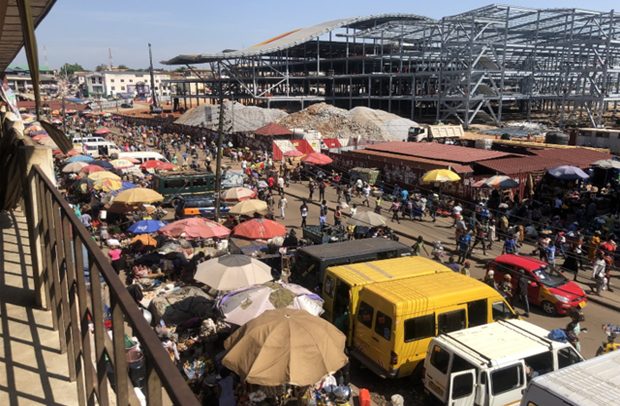The new infrastructure
SO MUCH noise made about the construction of the on-going Kumasi Central Market excited me to visit the project site for myself on a sunny Monday morning, October 10, 2022. Traders, both male and female, who have been evicted to allow for the construction of the new ultra-modern market facility have taken over the streets and the pedestrian paths close to the market to display their wares.
The redevelopment of the Kumasi Central Market is the phase two of the Kejetia project initiated by the Government of Ghana. The project, which is planned to be bigger than the Kejetia Market, is estimated to cost €248 million. It is expected to house 6500 rental spaces, 5400 cold storage units and 800 kiosks, 50 eateries and many more, all of which will fit into the four-storey massive market.
But until the project is completed and stores are allocated, ejected businessmen and women as well as petty traders and hawkers, who are engaged in brisk business activities will have no choice but to sell on the streets and pavements.
The situation has made movement into and out of the area very difficult. As I maneuvered my way through the crowd of people under the scorching sun, I could not help but feel suffocated by the thick polluted air. I wondered how traders managed to cope with such an environment as they plied their trade.
Buyers at the market come from far and near. Some come from Ejisu, Offinso, and many more places in Ashanti and other nearby regions. Other buyers come from countries such as Benin, Togo, and other neighboring countries. They all converge at the busy streets right in front of the Kumasi Central Market which is currently under construction.
The second phase of the redevelopment of the Kejetia Market was programmed to begin on May 2, 2019, but because of the congestion problem at the market and the difficulty in allocating stores to all the traders at the completed Kejetia Market, the project had to begin on March 30,2022, and it is projected to be completed in June 2024.
However, the congestion problem has not been thoroughly addressed yet. I don’t think that it will be solved until the Central Market project is completed. Until its completion, authorities have tried to put in place temporary measures to reduce the congestion problem that currently faces the market.
Kumasi city managers have, in collaboration with other municipal assemblies, adopted decentralisation methods by convincing traders to relocate to satellite markets constructed at Abinkyi, Bantama, Tafo-Pankrono and other places to discourage buyers from flocking to the central market area to transact business.
Though this measure has relatively helped in reducing the pressure placed on the small area where the traders have had to occupy, the problem of congestion still persists.
Furthermore, vehicles find it difficult to manoeuver through the streets overtaken by buyers and sellers who sometimes seem oblivious to cars honking at them to make way for them to pass. A driver can spend nearly 30 minutes on that short stretch of road just trying to navigate through without hitting someone.
Pedestrians, especially first timers, find it so difficult to find their way through the market. I got lost on several occasions because of how packed the place was. When I was tired and needed a place to rest for a while, I quickly found to my horror that there was no such place of rest. I had to keep walking to avoid a stampede.
Another problem that I noticed at the Central Market was about sanitation. There were heaps of rubbish everywhere I turned. The piled-up garbage seemed to have been left for weeks. The gutters were also chocked emitting offensive smell yet some market women kept pouring dirty water into them.
I ended my tour at the beautiful Kejetia Market. Through interactions with some of the traders, I was better informed about some of the problems facing them. While some of them expressed displeasure at the obscure location of their shops making buyers find it difficult to patronise their goods, others complained about high electricity bills.
There is no doubt in my mind as I conclude that strategic measures can be taken by city managers to address the problems stated in this write-up to improve upon the trading conditions at the Kumasi business district before and after the completion of the redevelopment of the Kumasi Central Market project.
To achieve economic boom at the new market, government must involve the traders in every decision-making process. The traders must also be given an opportunity to elect leaders who can properly communicate their concerns. The traders must also be arranged according to the commodities they sell so that buyers can easily locate them.
I believe that when these suggestions are considered and implemented, the Kumasi Central Market will be one of the better-managed business centres in Africa.
BY Stella Botwe, Kumasi

